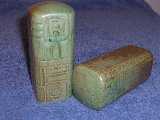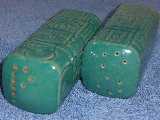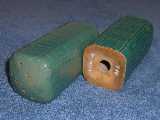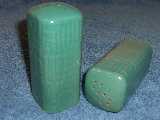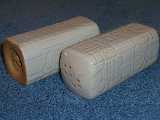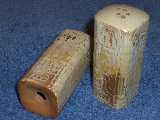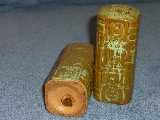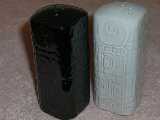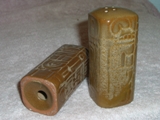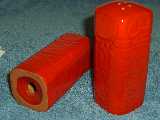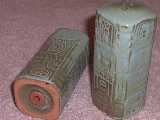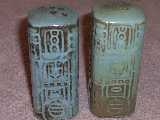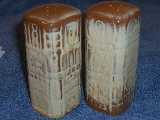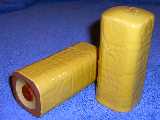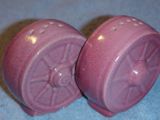

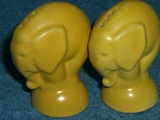
Mayan-Aztec Large Shakers
7H: 1942-1953
24H: 1968-1975
Frankoma probably designed the tall Mayan-Aztec shakers in 1941. I am getting this date for the dinnerware line from John Frank’s letter of 1970. Certainly development work had to be done by the end of 1942 to get the entire line of Mayan-Aztec dinnerware ready for market. Frankoma offered twenty-one MA pieces including the tall salt and pepper in the 1/1/1943 price list although none are shown in the 1942 or 1943 catalogs.
The “Aztec” part of the name was probably added at this time. In the 1936 catalog this design is simply called “Mayan”. In keeping with the recent policy of lettering shaker patterns with the “H” the mold became “7H”. These remained in production probably through 1953. Frankoma issued no catalog in 1954 and dropped the whole Mayan-Aztec line from the 1955 catalog. When Frankoma re-introduced the Myan-Aztec dinnerware line in 1957 they did not include the 7H shaker set. With possible rare exceptions these shakers will be on Ada clay. Some may exist on transitional clay from 1953 or red clay from 1954 but I have seen none.
I believe that John Frank included the "7H" in the master mold for these shaker sets. If so, every production mold and every shaker made with those production molds would have the "7H" molded into the base. Close inspection will prove that to be the case in most instances. Some marks were sponged until very faint and some were entirely obliterated. Although John Frank placed the mold number in the master mold on other shaker lines in the 1940's the 7H is the only one to continue in production after WWII.
One of the turquoise sets shown here is marked with the 19 mm incised oval “o” mark. Although rare on this shape, Frankoma marked many of their shakers with the standard oval “o” mark (25 mm) in the early 1940’s. I suspect that no shakers were base marked after 1942, but I have yet to confirm this.
The application of the S/P hole sets to the early Myan-Aztec shakers is most interesting. In the beginning clearly no standard applied. The first group, like the wagon wheels, is a "crude" S/P with large letters and random hole placement. Some were even made with the letters set square to the shaker! Before long the standard became a diagonal placement of the letters.
The Myan-Aztec shaker hole sets did not go thru the small S/P phase like the wagon wheels and other shapes. This indicates a possible break in production during the late or early post-WWII period. When the crude "S" phase ended production went directly to the big "S" and continued that way until displaced in 1953 by the double diamond "S". This is the same big "S" used on the wagon wheels and short Myan-Aztec shakers or the same period.
In 1968 when Frankoma introduced a new #24 Mayan-Aztec canister set they resurrected the old #7H shape and relabeled the shaker #24H. The #24 MA canister line including the shakers was dropped in 1976. This production run of only 8 years makes the #24H fairly scare even though they are newer.
These are usually identified by 1) a double-diamond “S”, 2) the lighter colored red Sapulpa clay, and 3) the glazed bottoms. These also would originally have the red rubber stoppers but keep in mind that stoppers are often replaced. Also, the glazing is occasionally left off the base. I have yet to see this shaker marked with the “24H”.
This group is also impacted by the change from American to Australian rutile in 1970 so you will see both the high contrasting early and the low contrasting later glazes.

